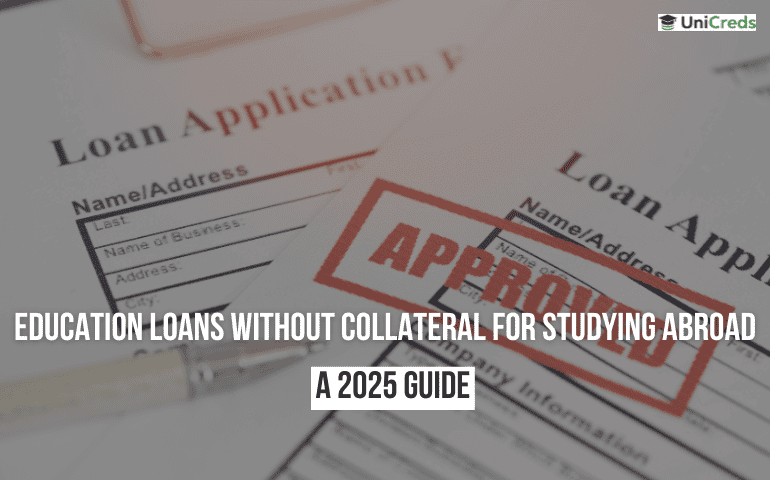Table of Contents
You made it to your acceptance mail, and probably you are in seventh heaven. It is ultimately worth the tremendous amount of ordeal. On your brain, where you fly on a plane, land in your dreamland, and become friends with a multicultural community of people.
You end up with a 5 or 6-digit income, your fluffy thought cloud says. But wait, before you can start your ride, some things are yet to be lined up. And these things include the not-so-cheap tuition fee that could leave you in a bundle of nerves.
You can’t help but apply for an educational loan because you have fraternal ties to a rich person. Almost 8 out of 10 education loan interest subsidy application forms opting for an abroad education loan are unaware of the interest rate’s uncertainty. And how post-sanction adjustments can occur. Here’s what you should be knowing about how education loan works:
How Do Education Loan Interest Rates Work?
As new student loans rates are released, a promissory note that outlines the loan’s terms is signed by the borrower. It is necessary to read and comprehend every aspect of this document, as it defines the amount you owe and when your payments are scheduled.
The essential words to watch out for are:
- Date of disbursement: The date that the funds arrive and interest begins to accrue
- Amount borrowed: The cumulative amount of each loan borrowed
- Interest rate: How long to borrow the funds you have to pay
- How interest accrues: Whether regular or monthly interest is paid
- First payment date: When you need to make the first payment for the loan
- Payment schedule: How many payments need to be made
Talking about how education loan works, lenders know that most full-time students do not have a salary, and it is not adequate to cover student loan payments while in school if they do. As a consequence, when you’re in school, it is always possible to stop making payments.
The government provides subsidised direct loans to students who show necessity. If you qualify, when you’re in school, the government pays your interest, so your balance does not rise. The interest on education loan becomes your obligation after you graduate, however.
Unsubsidised loans, meanwhile, from the day they are disbursed, incur education loan interest. Since you are not expected to make payments, debt will build-up, and with a loan balance greater than you began with, you will graduate.

Education Loan Interest Rates
Interest rates determine the additional cost you will incur on top of the borrowed amount. These rates can vary based on factors like the type of loan, your creditworthiness, and the lender’s policies. Having a clear understanding of education loan interest rates is essential for making wise decisions when it comes to financing your higher education overseas.
| Bank | Secured Loan Interest Rate | Unsecured Loan Interest Rate | Maximum Loan Amount |
| ICICI Bank Student Loan | 9.5 % | 10.4 – 11.25% | Secured: 80 lakh Unsecured: 40lakh |
| Axis Bank Student Loan | 9.9 % | 10.4 – 11.25% | Secured: 80 lakh Unsecured: 40lakh |
| Credila | 10.5 % | 11.5 – 12.5% | Secured: 1.5 Cr Unsecured: 50 lakh |
| Union Bank Of India | 10.5 % | 9.8 % | Secured: 1.5 Cr Unsecured: 50 lakh |
| IDFC Student Loan | NA | 11 – 12.5% | Secured: 50 lakh |
Banks With Lowest Education Interest Rates
Here are each bank with their respective education loan schemes and interest rates:
1. Bank of Baroda:
| Education Loan Scheme | Interest Rates (p.a.) |
| Baroda Scholar | 10.40% – 11.15% |
| Baroda Education to Students of Premier Institutions | 9.15% – 10.20% |
| Baroda Gyan | Up to 11.15% |
| Baroda Vidya | 12.50% |
2. State Bank of India (SBI):
| Education Loan Scheme | Interest Rates (p.a.) |
| SBI Take Over of Education Loan | 8.55% – 10.05% |
| SBI Global ED-VANTAGE | 11.15% |
| SBI Scholar Loan | 8.55% – 10.05% |
| SBI Student Loan | 11.15% |
3. Central Bank of India:
| Education Loan Scheme | Interest Rates (p.a.) |
| Cent Vidyarthi | 8.30% – 11.50% |
| Cent Vidyarthi for Executive MBA | 8.80% |
| Cent Skill Loan | 11.15% – 11.20% |
| Cent Vidyarthi IIMs and other reputed management institutes | 8.30% |
| Cent Education Loan | 8.30% – 11.25% |
4. Bank of India:
| Education Loan Scheme | Interest Rates (p.a.) |
| Bank of India Star Vidya Loan | 9.20% |
| Bank of India Star Education Loan | 10.95% – 11.75% |
| Bank of India Education Loan Abroad | 10.95% – 11.75% |
5. Punjab National Bank (PNB):
| Education Loan Scheme | Interest Rates (p.a.) |
| PNB Pravasi Shiksha Loan | 10.95% – 11.75% |
| PNB Honhaar | 11.25% |
| PNB Kaushal | 10.25% – 10.75% |
| PNB Udaan | 10.00% – 10.75% |
| PNB Pratibha | 8.55% – 10.50% |
| PNB Saraswati | 10.00% – 10.75% |
6. Union Bank of India:
| Education Loan Scheme | Interest Rates (p.a.) |
| Union Education Skill Development | 10.80% – 12.05% |
| Union Education Special Education Loan Scheme | 9.30% – 10.55% |
| Union Education Loan for Indian School of Business (ISB) Students | 8.55% – 9.50% |
| Union Education (Up to 7.5 lakh) | 11.50% |
| Union Education (Above 7.5 lakh) | 10.90% |
| Union Education Premier Abroad | 9.30% – 10.80% |
| Union Education – SPECIAL SCHEME FOR PREMIER MEDICAL INSTITUTES | 10.30% – 10.80% |
How Is The Education Loan Interest Rate Calculated?
Each month, your necessary loan payment will be the same. However, interest is paid when you deposit before any money goes into growing your principal. On your principal balance, the remainder of your payment is applied.
To get your “interest rate factor,” the interest rate is divided by the number of days in the year. The education loan interest rate factor is then compounded by the balance of the loan and multiplied by the days after your last payment. The effect is how much interest for that time you are paying.
How Is Student Loan Interest Applied?
Your balance and the amount of interest you accrue will decline when you make payments on your student loan. More of your contributions are added to your principal with lower interest charges.
The interest charged will decrease each month over the loan term, which speeds up the principal payment. That’s how amortisation works, merely a fancy way to say “paying down the principal on loan.”
Note that your payment balance goes into interest and any outstanding fees until your principal is reduced.
Your loan repayment deadline allows you to make the same minimum payment per month, whether you have an unsubsidised loan or are past the subsidy era. The interest continues to accrue whether you are on a payment plan or have deferred payments. Your principal is added to this number, growing the balance of your student loan.
While there are only a few chances for you to get an interest-free education loan; If you may, it can make sense to pay at least a month’s interest.
Your loan balance will continue to rise if you do not, and you will owe interest in the interest you have not paid in previous months.
In reality, making interest payments while you are in school will save you money in the long run if you have the capacity.
Your Education Loan Interest Rate Is Likely To Change & Here’s How
Most of education loans come with floating interest rates, which are determined by a combination of a variable Index and a fixed Spread. Understanding this interest rate structure and the role of the Reserve Bank of India’s MCLR formula is vital for borrowers to plan their finances efficiently.
- Floating Interest Rate: Educational loans in India typically have floating interest rates, which means the interest is calculated using a variable Index and a fixed Spread.
- Formula for ROI: The final Rate of Interest (ROI) is computed as Final ROI = Index + Spread, with the Spread generally ranging from 1% to 2%, varying by bank or lender.
- Variable Index: The variable Index represents the Minimum Rate of Interest set by the bank. It depends on specific factors and is subject to fluctuations based on economic conditions.
- New MCLR Formula: The Reserve Bank of India (RBI) introduced the Marginal Cost of Funds-Based Lending Rate (MCLR) formula to determine the variable component in the Index, providing transparency to borrowers.
- Example Scenario: Suppose your educational loan’s floating rate is set at a one-year MCLR of 10% and a Spread of 1%. In this case, your total ROI would be 11% (10% + 1%) until the next Reset Period.
- Reset Period: The Reset Period is the duration after which the interest rate is revised. Different banks have varying Reset Periods; for instance, SBI’s is one year, while Axis Bank’s is six months.
- MCLR Revision: If the MCLR gets revised to 9% during the next Reset Period, your new ROI would be 10% (9% + 1%).
- Mandated Formula: Banks are mandated to use the MCLR formula, ensuring that any benefits of policy rate cuts are directly passed on to borrowers. This offers more clarity and predictability in interest rate changes.
What Factors Determine Education Loan EMI Calculations?
Education loan EMI calculations are influenced by three key factors that borrowers should consider:
- Loan Amount (Principal): The loan amount sanctioned by banks or financial institutions directly affects the EMI. Higher loan amounts will result in higher EMIs, as the interest is calculated as a percentage of the principal. Borrowers should carefully assess their actual financial requirements and opt for a loan amount that is manageable and necessary for their education expenses.
- Tenure: The loan tenure, which is the period over which the borrower repays the loan, has a significant impact on the EMI. Longer tenures lead to lower EMIs but may result in higher total interest payments over time. Conversely, shorter tenures mean higher EMIs but reduce the overall interest burden. Borrowers must strike a balance between comfortable EMI payments and minimising interest costs.
- Interest Rate: The interest rate charged by the lender significantly influences the total cost of borrowing. It’s essential for borrowers to shop around and compare interest rates from different lenders to secure a competitive rate. Maintaining a good credit score and financial standing can also enable borrowers to negotiate better terms with lenders, reducing the overall interest burden.
To simplify the process of calculating EMIs and making an informed decision, borrowers are advised to use an education loan EMI calculator. This tool provides instant results, allowing borrowers to select an EMI that suits their financial capabilities without straining their budget.
By considering these factors thoughtfully, individuals can manage their education loans responsibly and plan for a successful future.
FAQs
1. Is interest paid monthly for education loan?
During the moratorium and course periods, the accrued interest is added to the principal. Repayment is then set through Equated Monthly Installments (EMIs) with a fixed amount throughout the tenure.
2. How is interest charged on education loan?
Indian bank education loans usually incur simple interest while the tuition fees are disbursed during the moratorium period. However, once the repayment begins, the interest is charged on a compound basis.
3. Which bank interest is low for education loan?
For students seeking education loans with lower interest rates, considering banks like ICICI Bank, Axis Bank, Union Bank of India, State Bank of India, Punjab National Bank, Bank of Baroda, and Central Bank of India would be beneficial.
Popular Loans
Loans for studying in USA | Loans for studying in UK | Study loan for Canada | Education loan to study in Ireland | Loans to study in Australia | Student loans for New Zealand










0 Comments